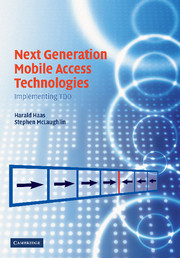Book contents
- Frontmatter
- Contents
- List of abbreviations
- Acknowledgements
- 1 Introduction
- 2 Wireless telecommunications using CDMA and TDD techniques
- 3 Interference and capacity analyses
- 4 Centralised DCA algorithm using the TS-opposing idea
- 5 Distributed DCA algorithm utilising the TS-opposing idea
- 6 UTRA-TDD Opportunity-Driven Multiple Access (ODMA)
- 7 Routing strategies in multi-hop CDMA networks
- 8 Multi-hop DCA
- 9 Radio resource metric estimation
- 10 Interference-based cancellation techniques for TDD
- 11 Smart Antennas for TDD-CDMA Systems
- 12 Cellular OFDMA-TDD
- 1 Derivation of T: Unconstrained Optimisation
- Bibliography
- Index
1 - Introduction
Published online by Cambridge University Press: 02 September 2009
- Frontmatter
- Contents
- List of abbreviations
- Acknowledgements
- 1 Introduction
- 2 Wireless telecommunications using CDMA and TDD techniques
- 3 Interference and capacity analyses
- 4 Centralised DCA algorithm using the TS-opposing idea
- 5 Distributed DCA algorithm utilising the TS-opposing idea
- 6 UTRA-TDD Opportunity-Driven Multiple Access (ODMA)
- 7 Routing strategies in multi-hop CDMA networks
- 8 Multi-hop DCA
- 9 Radio resource metric estimation
- 10 Interference-based cancellation techniques for TDD
- 11 Smart Antennas for TDD-CDMA Systems
- 12 Cellular OFDMA-TDD
- 1 Derivation of T: Unconstrained Optimisation
- Bibliography
- Index
Summary
Introduction
Over the last 20 years personal computers have developed as a mass consumer product which, coupled with the growth in widespread broadband access, offers users a multiplicity of services. The Internet is an enormous source of information (both valid and invalid) that has evolved into a virtual store, a library, a chat-room and a playground, and has enabled novel means of interacting. The simple email service is an example of how material streams (transport of letters, documents, etc.) have been replaced by information streams. These issues are leading to fundamental changes in how we do things.
A further significant step in the ‘digital revolution’ has been the demand for mobility, the so called anyone, anywhere, anytime mentality. Over the world digital mobile telephony has been a huge success. In particular, in Europe, the foundation was laid when 13 countries agreed to adopt a single digital standard for cellular mobile communications (The Memorandum of Understanding (MoU) signed on 7 September 1987 in Copenhagen). The development of the Global System for Mobile communications (GSM) followed, and the historic milestone of 1 billion mobile subscribers was reached in 2000 (Eylert, 2000). It is predicted that by the year 2010 there will be more than 1.7 billion terrestrial mobile subscribers worldwide.
- Type
- Chapter
- Information
- Next Generation Mobile Access TechnologiesImplementing TDD, pp. 1 - 14Publisher: Cambridge University PressPrint publication year: 2008
- 1
- Cited by



